This article offers a step by step guide, drawing on ESTA's EnCO framework, to review and refine your Catalyst and Performance Metrics to thrive as an energy conscious organization.
Its aimed at supporting Management Reviews conducted by master practitioners, leaders, senior managers, suppliers and steering teams.
Do you know whether you’re only using what you need?
- Most organizations consume much more energy than they need – this adds extra cost and environmental impact.
- Many of us have more energy & sustainability processes than we need – this adds friction & makes it all harder to do.
- Energy is often marginalized within organizations – because it’s seen to be a technical subject, not interesting or not understood.
- Consequently energy is not deemed to be core business or it’s contracted out to service partners and then side-lined.
- The result: strategic decisions are made without considering energy use, its cost or other impacts.
“Surely our automatic monitoring & targeting system deals with energy performance for us – so we don’t need to think about energy!?”
“Our big thick energy manual has it all covered – our people just need to read it all!”
Yes, many of us are taking actions, but there’s so much more we can do.
Experience shows most of us struggle to optimize solutions. We may lack the engagement, alertness, skills, recognition or ability to adapt.
Follow this guide to find out to go to the next level.
Why is Energy important to ‘All of Us’?
People deliver business plans. Energy drives the buildings/processes they need.
Energy demand is ever increasing due to economic and technological developments, and increasing population.
Supply can easily be disrupted – energy is a dynamic global issue, it’s politically sensitive, it crosses borders and (still) relies on exhaustible energy resources.
Energy is the primary contributor to climate change – it is a key target for regulation.
Policies for cleaner air are also putting pressure on shifting energy systems.
Pressures for electrification (transport/heating systems/etc.) means costs are likely to rise unless we can significantly bring down existing consumption.
Understanding energy use allows us to quickly adapt to external changes/internal factors.
‘Only using what we need’ is crucial in ensuring our demand doesn’t outstrip supply.
Step 1: It starts by highlighting reality
How balanced are your pillars for success?
Success requires a balance in technical, people and organizational practices:
All these can offer good opportunities for energy savings:
Technical energy efficiency projects, automated controls, planned preventative maintenance, design & development, monitoring & targeting systems and system optimization.
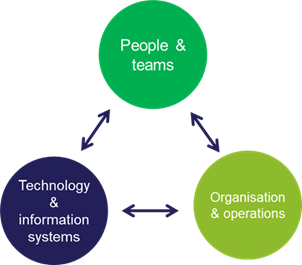
But in reality they rely on People and Organizational practices to work well
- How confident are you that you’re only using what you need?
- What are your opportunities and priorities to thrive as an Energy Conscious Organization (EnCO)?
This guide uses an illustrative framework to check confidence for only using what you need & the checkpoints to ensure:
- Balance in outcomes – to deliver the 'Win for All’ to lock in benefits long-term
- Balance in skills – for an integrated approach to make it all intuative & easy
- Balance in measures – to check energy performance against goals & activities
Success is not about following any specific framework, but about being able to ask the right questions to the right people at the right time.
We see ultimate performance is the point when you’re absolutely confident you’re only using what you need.
The 5 Pillars for Success for an Energy Conscious Organisation (EnCO)
Engagement | Alertness | Skills | |Recognition | Adaption
- Developed by the Energy Services Technology Association (© ESTA).
- EnCO is a simple self-analysis tool to help assess the five people pillars for success.
- These are related and interdependent to define an Energy Conscious Organisation.
- The EnCO Matrix is used to assess the 5 pillars against 5 levels:
- Level 0 to indicate little or no progress
- Up to Level 4 to represent best practice
- Use informal conversations with colleagues as the basis to discuss and agree which levels apply to create the ‘current’ position.
- The profile, along with antidotal feedback from colleagues, forms the benchmark & the EnCO confidence score.
- An uneven profile highlights the weaknesses that can undermine the strengths.
Step 2: Win for All Catalyst - Engagement
Is everyone engaged in the right way for the ‘Win for All’?
Typical Problems:
- Very little or no engagement in energy & sustainability management across the organization.
- We limit the team to dedicated energy managers & possibly investment teams.
Common Best Practices:
- Specific reduction targets set by top management.
- Coordinated team working towards common goals.
- All levels enthused and taking positive action.
Organizations come into being because there are tasks that are far too big for one person to do.
John Adair
Action Centered Leadership
Engagement is about creating the right conditions so colleagues can contribute:
- to organizational goals,
- in a way that benefits the people involved - the ‘Win Win’.
The ultimate outcome is a ‘Win for All’ – our organizations, our customers, our planet and ourselves.
It needs to involve All of Us
For any given task, we need to bring together the team with different perspectives, and then meet the needs of the individuals.
Asking the Right Questions:
- Do you fully understand the context & needs/ expectations of your key stakeholders?
- Is there a good compelling vision/ mission with a set of priorities/values in place?
- Does everyone understand their role in delivering these?
- Are you measuring, nurturing and continually improving your engagement?
Step 3: Alertness
Are all colleagues alert to the energy opportunities and measures to take?
Energy management through people is often one of the quickest & most cost effective ways to save energy & enhance sustainability
![heathrow_case_study_2-min[1]](https://biggreenacademy.com/wp-content/uploads/2020/08/heathrow_case_study_2-min1.png)
Our eye opener: We keep coming back to this airport case study as it was our eye opener. The green columns show the savings achieved by the team. We’ve been working with the airport ever since. See Heathrow case study.
Typical Problems:
- Little alertness/awareness at various levels within the organization to save energy.
- No mechanisms in place to alert people of energy waste when it occurs.
Common Best Practices:
- High levels of alertness to eliminate energy waste and prioritize actions.
- Colleagues proactively seek opportunities and innovate new measures.
- Positively impacting on other business priorities e.g. better service, skills, etc.
A collaborative approach means there’s more upfront discussion about opportunities & the questions to ask:
- Are goals and objectives realistic?
- Are (strategic) activities delivering balanced outcomes for key stakeholders?
- Which dragons of inaction are impacting on levels of alertness & action? (see box)
- Are there adequate surveillance controls in place to monitor for changes in context & requirements?
The 7 Dragons of Inaction
According to psychologist, Robert Gifford, there are 7 reasons why colleagues may not fully engage with your catalyst for change:
1) ‘Limited cognition’: people tend to only have the capacity to think about short-term objectives, e.g. “My priorities are elsewhere.”
2) ‘Discredence’: there’s a natural mistrust or denial to new things, e.g. “I don’t believe people can make a difference.”
3) ‘Comparisons with other people’: to justify why they should do more, e.g. “if other people aren’t doing anything, why should I?”
4) ‘Sunk costs’: it’s usually hard to buy into something that conflicts with previous efforts, e.g. “we’ve tried it before, it didn’t work.”
5) ‘Perceived risks’: could be social, psychological, financial or physical, e.g. “it wouldn’t be normal for me to be green”
6) ‘Ideologies and beliefs’: people set their views to justify why they shouldn’t take action, e.g. “the boss won’t like it.”
7) ‘Limited behaviors’: some people offer tokenism; e.g. “we recycle, isn’t that enough?”
Step 4: Skills
Do your colleagues have the right skills to exploit the opportunities?
Typical Problems:
- Few or no skills in energy management across all levels of the organization.
Common Best Practices:
- Skills gap analysis conducted & plan in place to close identified gaps.
- Everyone fully skilled in their energy management roles.
- Commitment to continual learning and up-skilling by ongoing investment in education, competency and training.
The Balance of Skills for Change
Prosci’s ADKAR model illustrates we need skills for an integrated approach:
- It starts with Awareness
- Then comes the decision to get involved; we need to create Desire
- After desire comes Knowledge
- Then Ability to make change
- For change to be sustainable, Reinforcement is needed
Focus efforts on Proficiency
- Studies have shown that Ability is often a defining factor for successful change.
- It is a common error to think Awareness alone improves performance.
- Awareness increases Knowledge but, for it to be effective, it needs to be part of an integrated skills approach.
- Reinforcement often relies on Desire and the Balance of Skills to deliver success in outcomes.
- Do top management, practitioners & significant users have the skills to deliver the activities required?
- Have you absolutely minimized the amount of controls/procedures in use?
- Are tools in place to make the activities as quick & easy as possible?
- Can training/coaching/gamification help with developing confidence, skills & performance of those involved?
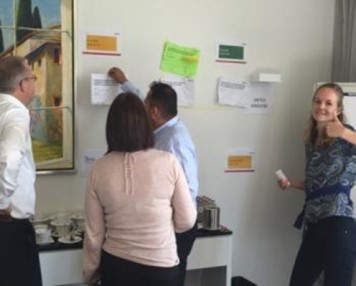
This champions’ training program for a logistics company, not only meant ISO 50001 certification was achieved in record time, but that they also had the diversity and integration of skills for their efforts to be effective in the longer term – See Vanderlande Case-study.
This is a fantastic achievement and demonstrates how a collaborative and focused approach can bring our teams together from different countries and at all levels in our business to gain this certification so quickly. I am impressed with the team’s commitment to energy management and their enthusiasm in meeting the aims of our policy.

Gert Bossink
2018, as COO for Vanderlande
Step 4: Performance metrics - Recognition
Are you recognizing, measuring and reporting the results?
Typical Problems:
- No recognition of the benefits of energy management, savings achieved or those making savings.
Common Best Practices:
- Data systems in place with capacity to recognize savings achieved against robust targets.
- Recognizing benefits and co-benefits.
- Those making savings are routinely recognized and celebrated.
Link metrics to people & results
- Target measures that energize teams.
- Energy crediting systems can link savings to people and teams to facilitate recognition & reward – bottom-up savings should also be verified top-down.
- Dashboards/ trackers/ apps help people to make quicker/better decisions and reinforce & maintain momentum.
- Whether it be absolute or intensity measures that are better will depend on the situation.
The Balance of Measures
- Primary measures (overall organizational performance)
- Secondary measures (system/process or local performance)
- Indicative measures (which explain why performance has changed)
Measures can be either Lead or Lag:
- Leading (input) indicators offer the opportunity to change, but do not guarantee success
- Lagging (output) measures are used to assess past performance; they’re usually easier to measure but are after the fact
For best results, we need a balance of measures
Are you delivering the right results?
- Are metrics communicated in a concise way so everyone understands how they contribute to strategic goals?
- Do evaluation controls adequately monitor progress and provide feedback?
- How are people rewarded for success?
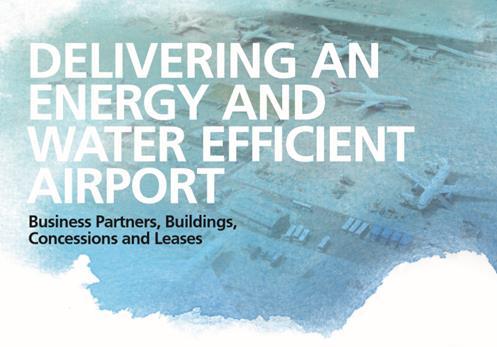
A Shared Vision of 3 priority success measures:
1) Reduce consumption (community measure)
2) Better utilization of resources (local business level measures)
3) Doing it together (ideas and actions trackers)
Bringing together a UK airport community
- In 2018, a UK airport set about bringing together business partners around a shared vision for better energy & water efficiency.
- The challenge is that tenants & concessionaires are all individually responsible for their own energy consumption.
- A shared vision was co-created focused on 3 priorities and the balance of measures.
- Recognition & celebration is based against agreed targets & action plans, along with better reporting and recognition of consumption.
- The approach was signed off by the airport’s sustainability partnership board of business partner CEOs as a published vision.
- See the airport case-study for more details.
Step 6: Adaption
Do your policies and practices effectively drive continual improvement and momentum?
Typical Problems
- Change is viewed as a threat rather than a positive challenge and opportunity.
- No energy policies, procedures or mechanisms in place to adapt to change.
Common Best Practices:
- The organization positively expects and embraces change.
- Energy policies & procedures are continually under review to allow for greater flexibility, response & momentum.
- Adapt to minimize risk and maximize opportunity to maintain continual improvement in energy performance.
ISO 50001 is the international energy management system standard to help us
Apply ISO 50001 in a streamlined fashion for effective continual improvement. Balance strategic thinking & controls with operational management processes
Do you need to adjust your plans?
- Are your goals and objectives realistic in the current (and future) context?
- Are you focusing on the right priority energy management activities?
- Does your team have the required skills and resources to deliver the activities?
- Do you have the right (minimum) checkpoints in place to monitor activities?
- Are your evaluation and feedback processes adequate?
- Are you achieving the right goals? Will you be delivering the right results in the future?
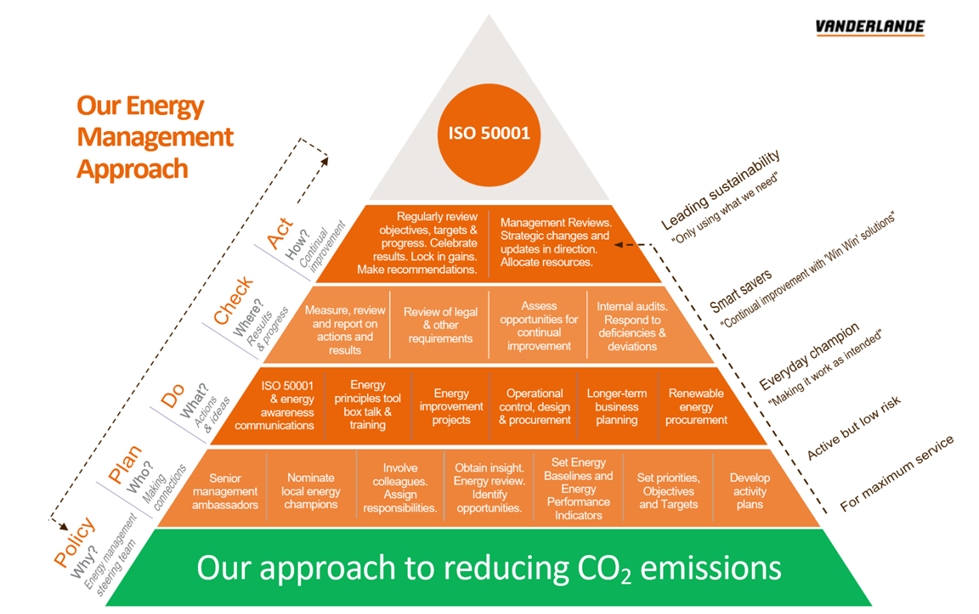
- This pyramid is an example of a strategic map that shows everything Vandelande needs to think about, how it all fits together with a clear line of sight to strategic objectives. It describes their Catalyst for change.
- Not only does this communication tool help to raise awareness and make sure the approach is understood, but it also tests the strategy & plans to ensure the organization is only using what it needs. See case-study.
Most impactful activities + the right checkpoints = confidence you’re only using what you need
What’s next?
Are you always asking the question ‘what’s next’ to drive momentum?
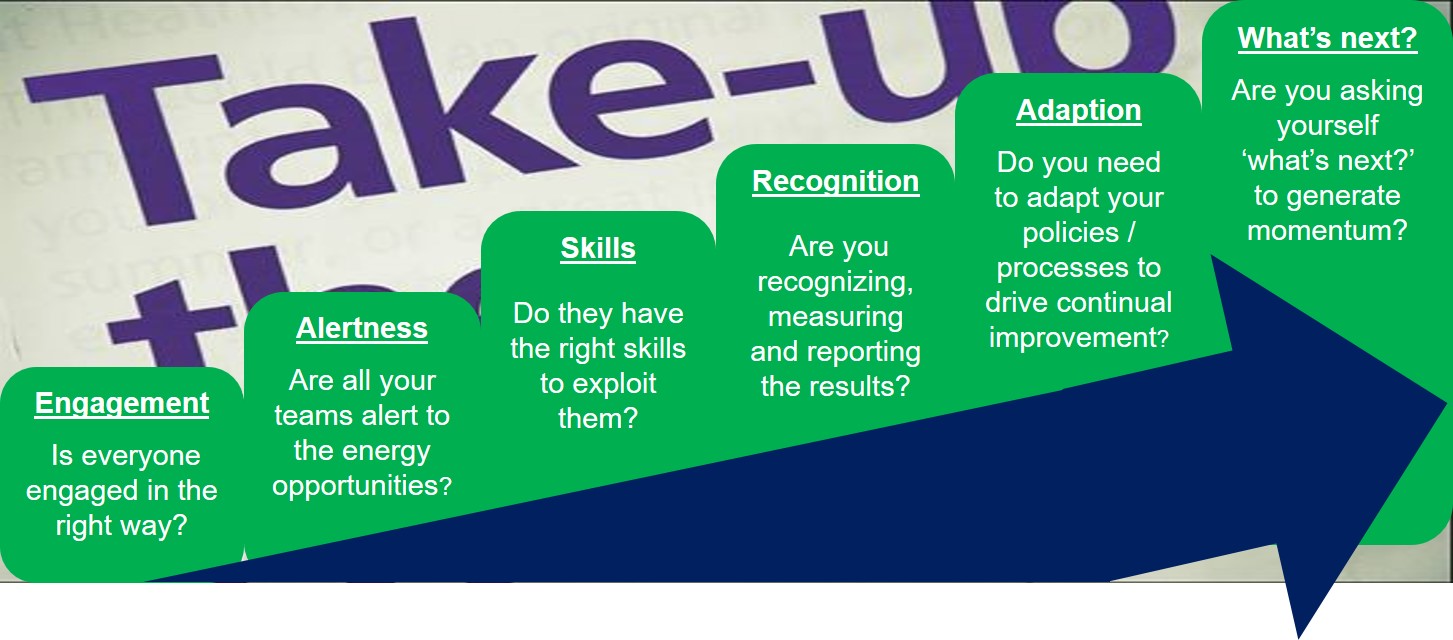
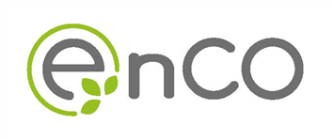
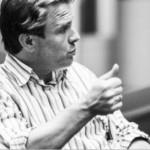
Written by James Brittain

